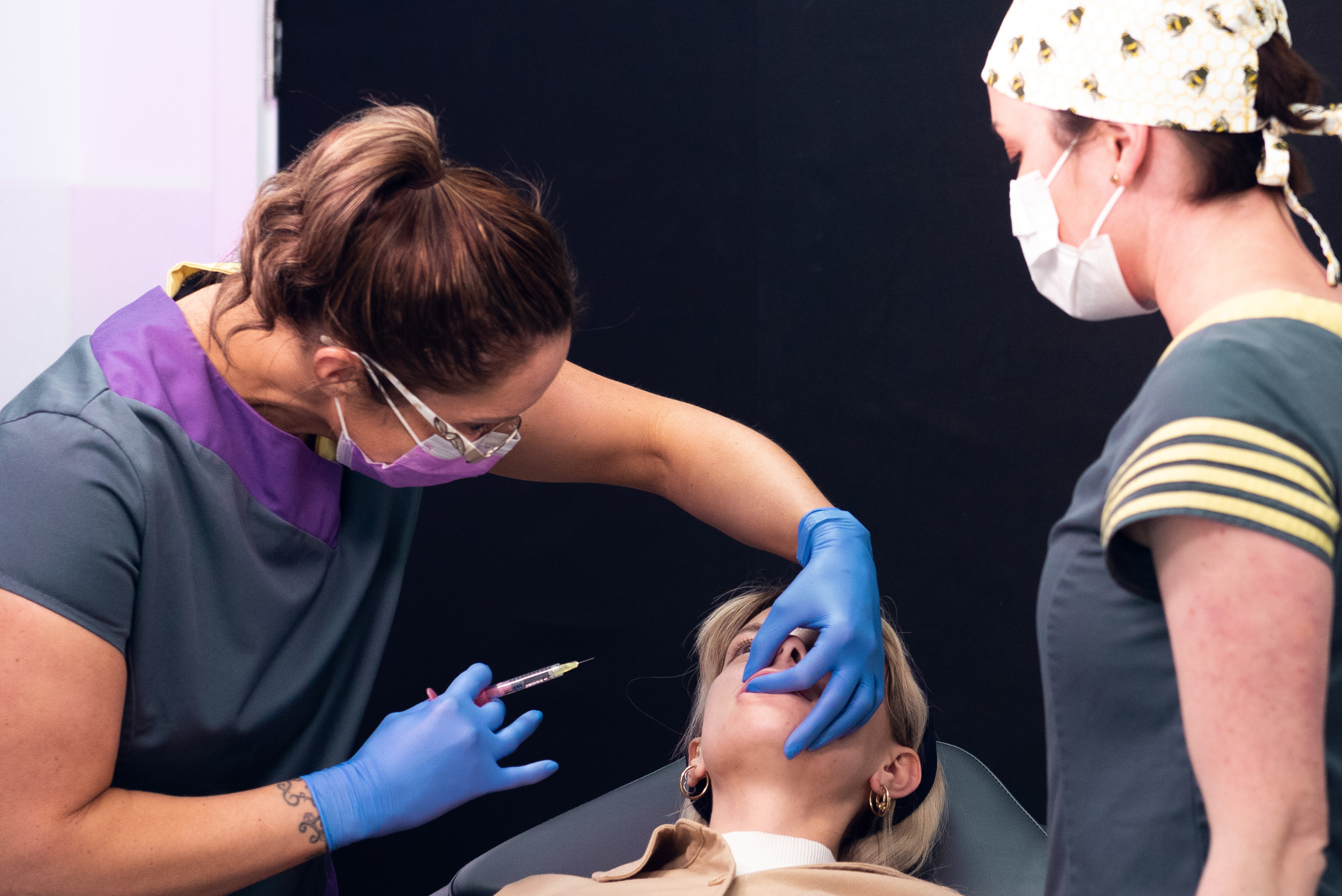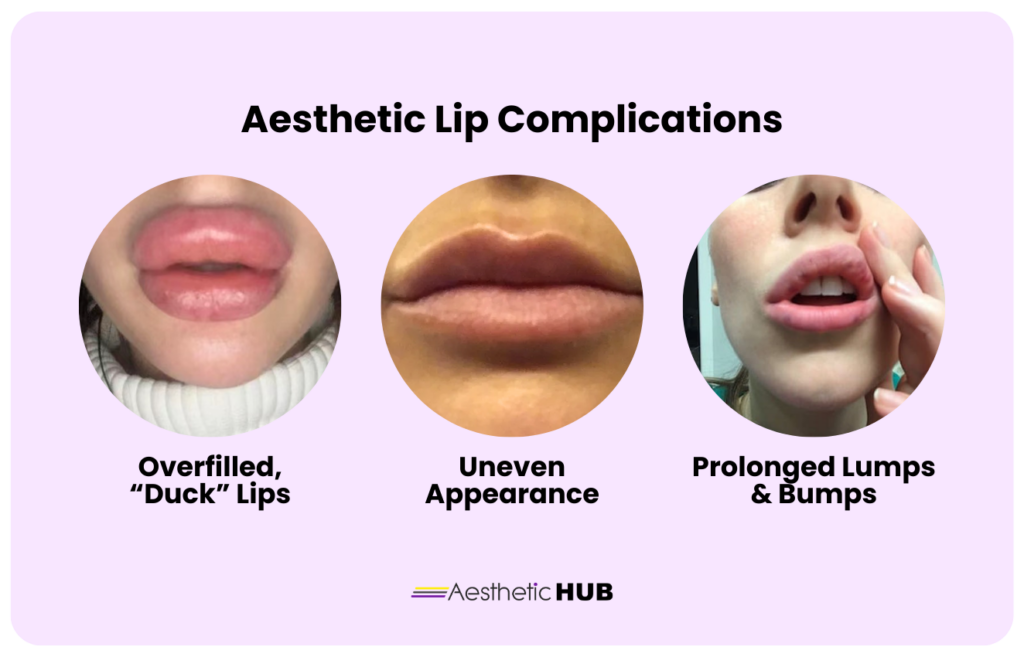
8 Signs of Lip Fillers Gone Wrong (And How to Prevent It)
12 December 2024
In this post:
- Learn about the most common errors in lip filler treatments, such as overfilled lips, uneven distribution, and the use of poor-quality fillers.
- Explore aesthetic and medical complications of poorly executed lip fillers including duck lips, infections, and tissue necrosis.
- Find out how the best injectors prioritise patient safety through proper training, technique, and continuous education to minimise risks.
- Dive into advanced treatment options to treat lip fillers gone wrong like facial ultrasound technology.
Lip fillers have long been the go-to for those looking for fuller, more youthful lips. And it’s not just celebrities and influencers buying into this dermal filler transformation anymore; even “normal” people are getting lip filler at increasing rates. We’re constantly exposed to people with lip filler, and it’s become a normal treatment for women of all generations to get.
What many don’t realise is the truly incredible lip filler transformations go undetected. The best injectors know how to use the dermal filler to enhance their patient’s natural lips to create a natural, seamless result.
When the best results go unnoticed, the cases of lip filler gone wrong come to the forefront of public attention. It’s true: not all lip filler treatments are created equal. The consequences of a poorly executed procedure can be significant.
If you’re in the UK, you’ll likely know that the aesthetics industry is largely unregulated. Because dermal fillers don’t require a prescription from a medical professional, anyone can inject from hairdressers to personal trainers. It’s reported that 59% of reported aesthetic complications come from beauticians with little to no medical background. To learn more on the lack of regulations in the UK, read our blog post on New Aesthetics Regulations for 2025.
This lack of regulatory oversight has normalised cosmetic procedures like lip filler and Botox, making them seem as casual as getting a manicure or getting your hair done. Many are under the impression that if they don’t like the result, they can simply dissolve the lip filler. But as we’ll discuss in this blog post, the reality is far more complex and potentially dangerous.

Common Lip Filler Injection Mistakes
If an injector doesn’t follow proper lip filler injection techniques, their patient can face consequences ranging from unsightly duck-like lips or more serious medical conditions like tissue necrosis.
Overfilling the Lips
This is one of the most common and recognisable mistakes in lip filler injection, and it’s also the one that gives lip filler a bad rep. When the worst cases of lip filler are the most noticeable, it causes some to falsely assume that all lip filler looks this way. This is not true.
Overfilled lips occur when too much filler is injected, or when an inexperienced injector fails to consider the natural proportion of the lips. Attractive lip augmentation requires a balanced approach to maintain harmony with the patient’s natural facial features.
Unevenly Distributing the Filler
Uneven results can lead to asymmetrical lips, where one side appears fuller or more protruded than the other. This often stems from improper injection technique or after a poor assessment of the patient’s natural lip anatomy.
Using Poor-Quality Filler
There are many different lip filler products out there, but not all of them are high quality. Inexperienced injectors are more likely to choose cheaper, lower quality fillers to keep costs down. Remember that cheaper rarely means better, and if an injector wants the best results for their patient, quality needs to be one of the first things they consider when choosing the best type of dermal filler.
Improperly stored filler can also negatively affect results. Dermal fillers should be stored in a cool, dry, dark place at no warmer than 25°C. Some fillers need to be refrigerated, so always pay attention to the package instructions.
Injecting Too Deeply
When an injector injects too deeply, this results in lumps, bumps, or nodules under the skin. In the severe cases, filler may enter blood vessels which can lead to vascular occlusion, tissue, damage, or even necrosis.
Risky Injection Techniques
Certain techniques, such as vertical injections for treating fine lines around the lips, carry a higher risk when performed by inexperienced injectors. If you’re a beginner injector, we recommend sticking with a lip filler injection technique like linear threading and save more advanced techniques when you have a bit more experience under your belt.
Signs of Lip Fillers Gone Wrong
There are two different types of lip filler complications. The first are aesthetic complications, ones that can shatter a patient’s confidence and leave them with regrets over getting the treatment done in the first place. While this kind of complication can be emotionally distressing, there is usually no physical pain or discomfort involved.
The second are medical complications, and these can happen in conjunction with aesthetic complications. Medical complications cause physical pain and discomfort and pose a real medical risk to patients. If not treated promptly, these complications could become permanent.

Some examples of aesthetic complications are:
- Overfilled, “Duck” Lips: Too much filler creates a disproportionate, unnatural look.
- Uneven Appearance: Lopsided or uneven volume distribution
- Prolonged Lumps & Bumps: While lumps and bumps are normal and usually fade in the days after treatment, they may persist if filler is unevenly injected or clumped together.

Some examples of medical complications are:
- Allergic Reactions: Sometimes a complication is not the injector’s fault. Though rare, a patient could be allergic to the filler used in their treatment. These symptoms include swelling, redness, itching, or in severe cases, anaphylaxis.
- Infections: Any skin puncture carries a risk of infection. When infections happen after a lip filler treatment, it is usually due to unsanitary clinical conditions or improper sterilisation.
- Nerve Damage: If the filler damages a nerve, the patient will typically experience numbness, tingling, or paralysis of the lips.
- Vascular Occlusion: A severe complication where filler enters a blood vessel and restricts blood flow. If left untreated, this can lead to tissue death (necrosis) or even filler blindness.
- Tissue Necrosis: The most serious risk, tissue necrosis is characterised by purple discolouration, severe pain, and pale skin.
If you suspect you have an aesthetic or medical complication, seek help from a medical professional trained in aesthetics right away. The longer you leave it untreated, the higher your risk for permanent damage becomes.
An Injector’s Responsibility
Preventing lip filler complications isn’t just about skill – it’s about having a commitment to patient safety. Good injectors should prioritise patient safety at every step of the way, from choosing the best filler products to the actual treatment.
It is an injector’s responsibility to undergo continuous education to stay on top of the latest techniques and technologies to ensure their knowledge of lip anatomy doesn’t falter. This helps minimise risks and ensures results your patient will love.
At the consultation, you should conduct a proper facial assessment of the patient’s lip structure, skin type, and their unique aesthetic goals. Some patients want a jaw-dropping transformation, while others only want small improvements. Don’t rush through the consultation; it allows you to create a tailored treatment plan with a high chance for success.
How to Fix Lip Fillers Gone Wrong
How you treat a lip filler complication largely depends on the severity. When patient symptoms become too severe, hyaluronidase alone might not be enough to resolve their complications. Hyaluronidase is an enzyme used to dissolve hyaluronic acid dermal fillers, but if a complication has progressed to the point of tissue death, a more intensive treatment is required.
Here at the Smileworks Aesthetic Training HUB, we instill in our delegates that it is not only their responsibility to prevent complications from happening but also to know how to treat them when complications arise. The best way to do this is with facial ultrasound guided injections.
In our Smileworks Liverpool clinic, Dr MJ Rowland-Warmann hosts the UK’s only dedicated complications clinic where she uses ultrasound to locate and address filler complications. Patients come from all over the world to treat their complications with Dr MJ, and she can tell you from experience that ultrasound is the best tool for treating lip filler gone wrong.
Remember: patient health and safety are paramount. A momentary aesthetic enhancement is never worth compromising a patient’s well-being.

Learn How to Treat Lip Filler Complications from the Expert
If you’re interested in learning the art of facial ultrasound, look no further than the Smileworks Aesthetic Training HUB – an esteemed aesthetic training centre based in the UK. We pride ourselves on our wide range of online and hands-on courses tailored for every skill level.
You can start with our beginner facial ultrasound course to learn the basics of how to use this revolutionary technology in your practice. We also have an Advanced Facial Ultrasound: Filler Recognition course that dives deep into how to recognise different types of filler.
Maybe you’re still a beginner lip filler injector. Our online lip filler course can teach you all the best lip filler techniques. Our lead instructor and co-founder Dr MJ will guide you through how to create gorgeous results for your patient.
We also have 1-2-1 mentoring sessions available for those looking for more personalised training. Regardless of your skill level, we have something for everyone at the HUB!
It’s time to embrace the prospering world of aesthetic medicine. The HUB provides you with all the right training and guidance you need to succeed. Take control of your professional journey and step into a future filled with endless potential and opportunities.
Join us at the HUB. Let’s shape the future of aesthetic medicine together and ensure safe, effective, and transformative results for every patient.
Want to try out our courses before committing? Take advantage of our free trial for a taste of what learning at the HUB is like.
Related blog posts:





